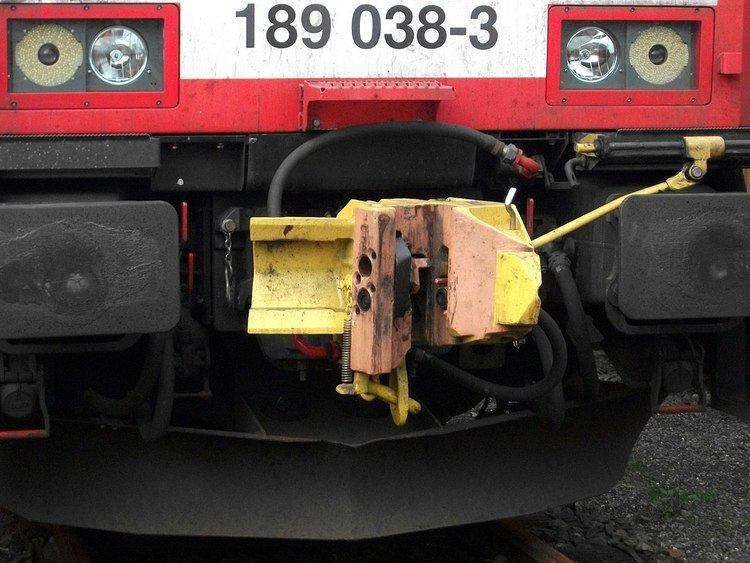 | ||
The C-AKv coupler is a fully automatic center coupler for railway vehicles, which is designed as a replacement for the European UIC standard chain coupler. Its profile is derived from the Willison design as used on the Russian SA3 coupler. The C-AKv coupler is compatible with both the buffers-and-chain setup and the actual SA3 coupler. C-Akv is from German Compact - Automatische Kupplung vereinfacht, meaning Compact automatic coupler simplified. Often the brand name Transpact is used as name for it.
Contents
History
In the 1970s a new type of automatic coupler was developed by the European railways. This was called the UIC automatic coupler and represented a West European variant of the AK69e type and the East European Intermat type. It was intended as a full replacement for the buffers-and-chain setup, as the latter is not suitable for heavy loads, very time-consuming to be connected, and requires intensive maintenance. As it would have had to be introduced all across Europe within a very short time frame, this introduction was repeatedly postponed. In addition, the UIC automatic coupler was not compatible with the existing chain couplings, which would have made it particularly difficult for some of the European state railways to carry out this conversion from a budgetary point of view.
The C-AKv coupler was developed by SAB WABCO, now Faiveley Transport Witten GmbH. Unlike the UIC automatic coupler, it is compatible with the existing chain coupler, which would allow for a longer transition period. Since the year 2002, the C-AKv has been on trial on the German railways. It is used on heavy coal block trains between the opencast mines at Profen and the Schkopau power plant. At this time, the German railways, Faiveley and the Technical University of Berlin are developing possible transition scenarios for a general introduction of the C-AKv coupler.
Heaviest trains
In a field test starting in 2004, the trains on the connection from the brown coal strip mine near Wählitz to the Schkopau Power Station were equipped with C-AKv-couplers which showed that regular wheel replacements shrunk below a third due to reduced wear. The solution has been kept and it spawned further investigations.
Beginning in late 2009, eighteen DBAG Class 189 electric locomotives owned by DB Schenker were converted to C-AKv couplers, in order to handle 6,000 tonne iron ore trains from Rotterdam to the steel works at Dillingen in the Saarland, replacing the previous German class 151 double units and Dutch class 6400 triple units commonly used on these workings previously. As these locomotives are also capable of operating on both the 15 kV AC and 25 kV AC (and 1.5 kV DC, for a short stretch under reduced power) overhead system on the German and Dutch networks, locomotive changes on the Dutch-German border are no longer required. Loaded trains are commonly operated by two 189s in a multiple unit setup, with the wagons retaining the AK69e type couplers they have been fitted with since the 1980s.
Design
Being an evolved version of the UIC AK69e coupler, the C-AKv coupler has the same basic outline as the SA3 coupler. Unlike the Russian SA-3 coupler, however, connectors for brake air lines and - if required - electric conduits are integrated into the coupler, which are automatically connected while coupling up. Also, these pneumatic and electric connectors are compatible with the buffers and chain setup, as opposed to previous types.
Since the brake line and electric connectors are integrated into the coupler's main body rather than in a separate body part below the main body, as had been the case on the AK69e type, it is possible to couple C-AKV equipped stock to stock not thus equipped.
The design is much more compact than the former SA3 coupler. The shape is slightly different from that of the SA-3 coupler, due to an additional alignment horn and the matching pocket on the opposite side. These two components allow for greater vertical stability in two connected C-AKv couplers.
